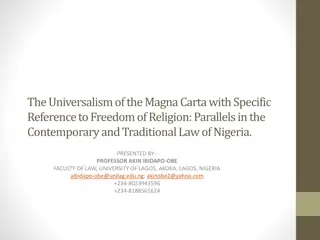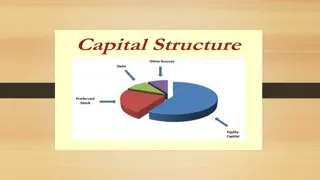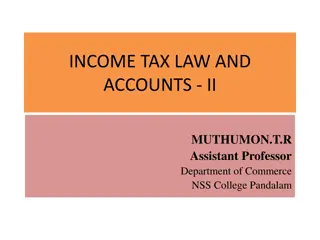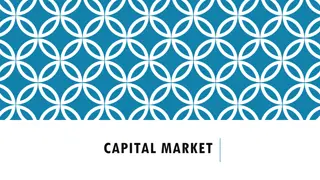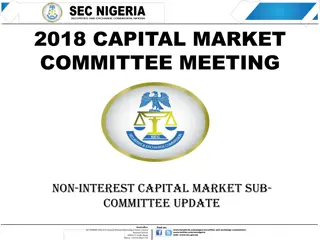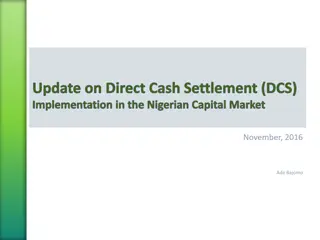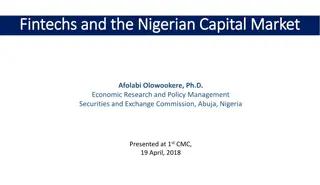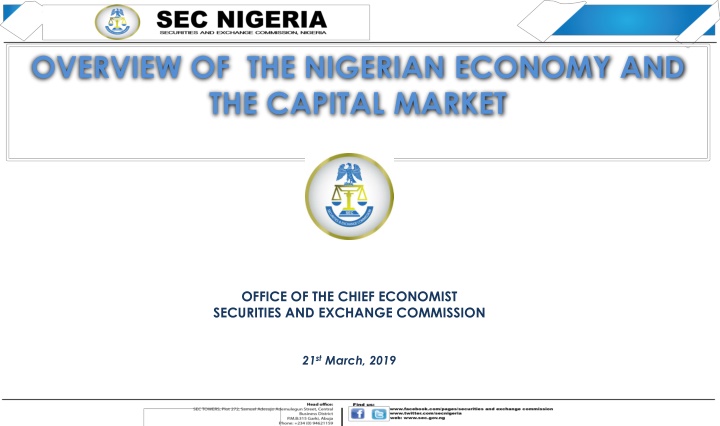
Nigerian Economy Overview and Capital Market Insights
The Nigerian economy's current status, growth projections, market trends, and key indicators such as GDP growth, inflation rates, and employment figures are discussed. Insights from the Office of the Chief Economist at the Securities and Exchange Commission shed light on various sectors including oil and commodities, primary and secondary markets, and the overall economic outlook.
Download Presentation

Please find below an Image/Link to download the presentation.
The content on the website is provided AS IS for your information and personal use only. It may not be sold, licensed, or shared on other websites without obtaining consent from the author. If you encounter any issues during the download, it is possible that the publisher has removed the file from their server.
You are allowed to download the files provided on this website for personal or commercial use, subject to the condition that they are used lawfully. All files are the property of their respective owners.
The content on the website is provided AS IS for your information and personal use only. It may not be sold, licensed, or shared on other websites without obtaining consent from the author.
E N D
Presentation Transcript
OVERVIEW OF THE NIGERIAN ECONOMY AND THE CAPITAL MARKET OFFICE OF THE CHIEF ECONOMIST SECURITIES AND EXCHANGE COMMISSION 21st March, 2019
Table of Contents The Global Economy Domestic Output and Growth Prices and Employment External Sector Activities Oil and Commodities Market Market for New Issues (Primary Market) Secondary Markets Product Development Trend of Listings and Delistings Outlook 1
The Global Economy (IMF, WEO-FEB) Global growth has weakened, and growth outlook has been revised to 3.5% from 3.7% (IMF) and 2.9% from 3.0% (WB) Slowdown in international trade and investment Escalation of trade tensions Tightening financial conditions Higher than expected slowdown in China No-deal brexit US monetary policy normalisation continued Federal funds rates increased to 2.25-2.50% in Dec 18. Further rate increases expected in 2019 and 2020 at a gradual pace Nigeria growth projected at 2.2% (WB) in 2019 driven by IMF reviewed growth downward from Production challenges Weakening oil prices Tighter global financial conditions may result in a possible capital flows reversal 2
Output and Growth The Nigerian economy expanded by 2.38% in the Q4 18. 0.57% than 1.81% recorded in Q3 18 Highest growth since Q3 15 Higher growth in the non-oil sector (2.70% from 2.32% in Q3 18), Lower contraction in the oil sector (-1.62% from -2.91% in Q3 18) Agriculture and services still the main drivers of growth GDP growth still below population growth Annual growth in 2018 was 1.9% The CBN and FBN Purchasing Managers Index (PMI) fell to 57.1 and 50.4 from points respectively in Feb 18 From 58.5 (CBN) and 51.5 (FBN) in Jan 18 Indicating slow down of growth in the sector Slow down in GDP growth expected in Q1 19 2017 2018 Sector Growth Rate (%) Q1 Q2 Q3 Q4 Total Q1 Q2 Q3 Q4 Total Agriculture 3.39 3.01 3.06 4.23 3.45 3.00 1.19 1.91 2.46 2.12 Industries -5.83 2.17 7.74 4.87 2.15 6.86 0.40 -0.11 0.95 1.94 Services -0.37 -0.85 -2.66 0.10 -0.91 -0.47 2.12 2.64 2.90 1.83 Real Growth Rates -0.91 0.72 1.17 2.11 0.82 1.95 1.50 1.81 2.38 1.93 Real Non-Oil Growth 0.72 0.45 -0.76 1.45 0.47 0.76 2.05 2.32 2.70 2.00 Purchasing Manager's Index 70 61.1 60.2 59.4 58.9 58.5 57.9 57.3 57.1 57.1 57.0 56.9 56.8 56.8 56.7 56.5 56.5 56.3 56.2 54.8 54.7 54.6 53.2 60 51.5 51.0 50.4 49.8 49.2 48.9 50 40 30 20 10 0 Jan-18 Feb-18 Mar-18 Apr-18 May-18 Jun-18 Jul-18 Aug-18 Sep-18 Oct-18 Nov-18 Dec-18 Jan-19 Feb-19 CBN FBN 3
Prices and Employment Inflation Rate (%) Headline inflation slowed down to 11.37% in Jan 19. - From 11.44% in Dec 18. Inflationary pressure expected to persist from: - Implementation of minimum wage - Expected food shortages conflicts in food producing areas - Fiscal spending 18.72 17.78 17.26 17.24 16.25 16.10 16.05 16.01 15.98 15.91 15.90 15.37 15.13 14.33 13.34 12.48 11.61 11.44 11.37 11.28 11.28 11.26 11.23 11.23 11.14 Apr-17 May-17 Apr-18 May-18 Dec-17 Dec-18 Mar-17 Mar-18 Aug-17 Oct-17 Aug-18 Oct-18 Jun-17 Jun-18 Jan-17 Nov-17 Jan-18 Nov-18 Jan-19 Feb-17 Sep-17 Feb-18 Sep-18 Jul-17 Jul-18 Unemployment rate(%) Under-employment rate(%) Unemployment rate rose to 23.13% in Q3 18 - Compared to 21.83% in Q1 18. - Rate has been rising steadily over time Underemployment also rose to 20.14% during the same period - But lower than the Q1 18 rate of 20.14% 20.14 20.10 20.18 20.45 21.19 21.06 20.98 20.39 19.7 19.3 19.1 23.13 22.73 21.83 20.42 18.80 16.18 14.44 14.23 13.9 13.3 12.1 16:Q1 16:Q2 16:Q3 16:Q4 17:Q1 17:Q2 17:Q3 17:Q4 18:Q1 18:Q2 18:Q3 4
External Sector External Reserves ($bn) Monthly Average Exchange Rate 47.8 47.6 47.5 47.1 46.3 45.8 600.00 44.3 43.2 43.1 50 42.5 42.3 42.2 42.0 40.7 45 500.00 36.9 34.3 33.8 40 32.5 31.8 30.8 30.7 400.00 30.3 30.3 30.2 29.6 27.9 35 300.00 30 25 200.00 20 100.00 15 10 - May-16 May-17 May-18 Aug-16 Oct-16 Aug-17 Oct-17 Aug-18 Oct-18 Sep-16 Sep-17 Sep-18 Mar-16 Apr-16 Jul-16 Nov-16 Mar-17 Apr-17 Jul-17 Nov-17 Mar-18 Apr-18 Jul-18 Nov-18 Feb-16 Dec-16 Feb-17 Dec-17 Feb-18 Dec-18 Feb-19 Jan-16 Jan-17 Jan-18 Jan-19 Jun-16 Jun-17 Jun-18 5 0 Jul-17 Jul-18 Jun-17 Jun-18 Apr-17 May-17 Nov-17 Dec-17 Apr-18 May-18 Nov-18 Dec-18 Aug-17 Aug-18 Jan-17 Mar-17 Jan-18 Mar-18 Jan-19 Feb-17 Sep-17 Feb-18 Sep-18 Feb-19 Oct-17 Oct-18 Official Parallel Exchange rate stable in 2018 CBN spot and parallel differential stable. Foreign exchange intervention: - FX stability prioritized by the CBN - Regulated allocation of forex - trade and industrial policy) Exchange rate to remained stable in January/February despite political risk premium External reserves rose to $43.1bn in Dec 18, from $40.7bn in Jan 18. - Movement mainly driven by oil price and foreign portfolio investors trade. Reached a peak of $47.8bn in Jun 18 Now around $42.3bn (Feb 19) Capital outflows CBN intervention Preference for exchange rate stability Debt service Eurobond issue proceeds 5
Fiscal Operation Fiscal Operations FAAC disbursement ranged from N655.2bn in Jan. to N812.8bn in Dec. 2018 Disbursement fell to N649.19bn in Jan. and N610.4bn in Feb. 2019 A reflection of the sharp decline in oil prices in December FAAC Allocation(N'B) 821.9 812.8 788.1 900.0 741.8 714.8 701.0 698.7 668.9 655.2 800.0 652.2 649.2 647.4 638.1 637.7 635.6 610.4 610.0 558.1 700.0 532.8 514.2 496.4 467.9 466.9 462.4 600.0 430.2 418.8 500.0 400.0 300.0 200.0 100.0 0.0 Jul-17 Jul-18 Jun-17 Jun-18 Apr-17 May-17 Dec-17 Apr-18 May-18 Dec-18 Aug-17 Nov-17 Aug-18 Nov-18 Jan-17 Mar-17 Jan-18 Mar-18 Jan-19 Feb-17 Sep-17 Feb-18 Sep-18 Feb-19 Oct-17 Oct-18 Total revenue of N3.96 trillion was raised in 2018 - Total expenditure was almost total revenue at N7.36bn 2018 budget has a deficit of N3.7trn against budget estimate of N1.9trn Revenue generation challenge Q1 2018 Q2 2018 Q3 2018 Q4 2018 Retained Revenue Expenditure Surplus/(Deficit) 884.88 1,125.31 1,035.72 916.44 2,015.60 1,630.11 1,890.80 1,826.85 (1,130.72 ) (504.80 ) (855.09 ) (910.40 ) still a 6
Primary Capital Market Activities New FGN bonds dominate the primary market In 2018, FGN issued N918.94bn worth of bonds. Equities issued N211.09bn 84% were equally divided between right issues and private placements IPO and offer for sale 16% Corporate bond segment improved to N323.59bn Higher than N23.15bn recorded for the whole of 2017 Fall in FGN issuance giving more space to corporates There were no sub-national bond issuance in 2018 Opportunities exist New Issues 1800.00 amounted to 1550.46 1600.00 1400.00 1308.30 1200.00 1070.24 1044.64 998.74 1000.00 918.94 800.00 600.00 344.71 323.59 306.50 400.00 211.09 127.37 120.90 103.17 97.39 81.54 78.54 66.92 60.95 200.00 47.00 23.15 20.00 10.58 11.73 0.00 2013 2014 2015 2016 2017 2018 Equities (N'B) FGN Bonds (N'M) Corporate Bonds (N'B) Sub-National Bonds (N'B) Supra-national Bonds (N'B)
Secondary Market FMDQ Total turnover in 2018 N182,856.9bn A growth of 28.7% compared to N142,029.4bn recorded in 2017 Treasury bills dominate the market Total turnover in Feb 19 N19,184.2bn 27.2% higher than Jan 19 turnover. All-Share Index NASD Total value in 2018 N30.8bn 608% higher than 2017 value of trade NN4.35bn Value of trade at the end of Feb 19 N1.1bn. 28.5% lower than the value recorded in Jan 19 AFEX Total value of traded commodities in 2018 N2.15bn 50.5% lower than the value of trade in 2017 N4.35bn Value of trade in Feb 19 N192.3mn 61.7% lower than the value recorded in Jan 19 (N502.7mn) Market performance was bearish for most of 2018: Coming from a high base in 2017. Weak investor sentiment. Persistent sell-offs US raising rates/ Election effect Elections now over Back to familiar terrain
Case for New Listing In1961,trading commenced with 19 securities (3 equities, 6 FGN Bonds,10 industrial loans) 320 listed companies in the history Currently about 162 217 216 214 213 212 207 202 201 200 198 198 196 196 196 195 194 190 186 183 182 181 177 174 170 167 164 153 142 131 111 102 100 99 96 93 93 93 92 91 81 42 36 35 35 34 We need new listing We need to be innovative in attracting them Are their other selling points apart from sourcing capital? What model works best? 1974 1975 1976 1977 1978 1979 1980 1981 1982 1983 1984 1985 1986 1987 1988 1989 1990 1991 1992 1993 1994 1995 1996 1997 1998 1999 2000 2001 2002 2003 2004 2005 2006 2007 2008 2009 2010 2011 2012 2013 2014 2015 2016 2017 2018 Indicators Minimum Maximum Average Median Mode Years to list 0 67 16 14 9 Years to delist 1 48 20 18 18 9
Emergence of New Products Emerging Products Merits of Regulation Deepen NCM market through increased number and value of products. Encourage more issuers and operators to come up with innovative products Engender transparency in the issuance, trading and pricing of innovative products Promote innovators business through credibility gained from regulatory endorsement and oversight Contribute to start-up, SME and commodity markets developments Enhance products liquidity as such products can be easily traded on standardised platforms Generate income for market participants and the regulator Encourage portfolio diversification and risk minimization Protect investors and discourage development of Ponzi schemes. Guide against violation of capital market laws and regulation The deepened to contribute more to the development of the country. New products and platforms have played into the regulatory space. Not traditional products regulated by the SEC. Combination of equities public offers, crowdfunding and collective investment schemes. It is important to recognize their existence and regulate them. The products are all available on the internet (public); they make promises of high and positive returns products are in units to which investors subscribe the issuing company manages investment on behalf of investors provide some form of insurance on investment profits are shared based on investors unit subscription Nigerian Capital Market needs to be
Outlook Implementation of the new OPEC oil quota which will impact Oil revenue Reserve accretion limiting forex intervention ......unless compensated by high oil price Sustained higher oil prices as a result of compliance with production cuts Market performance dependent on Familiar political terrain Trade policy/CBN Corporate earnings performance Policy direction of the government ..likely to be volatile over the next few months Global developments Political outcomes 11



